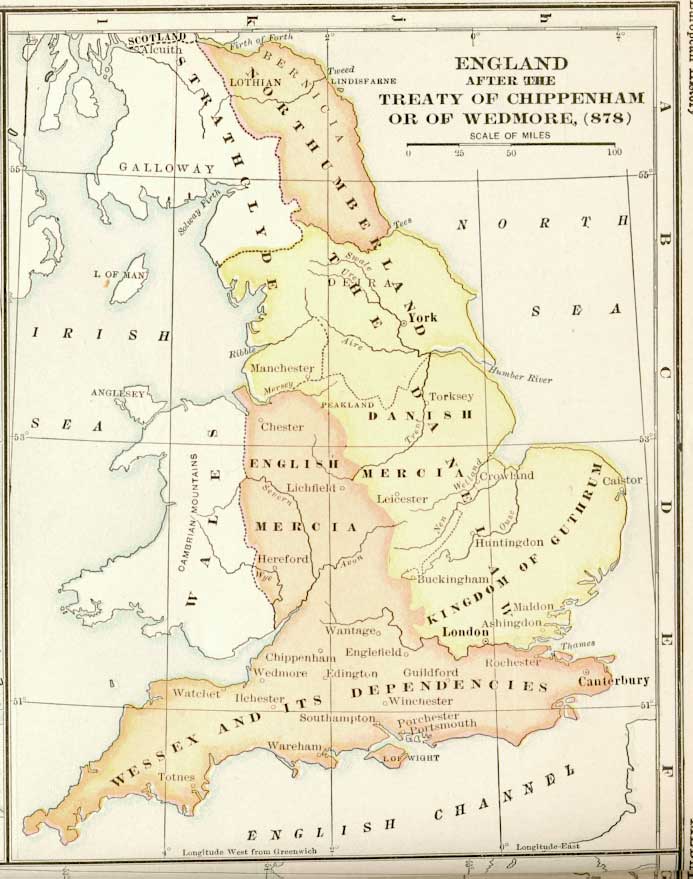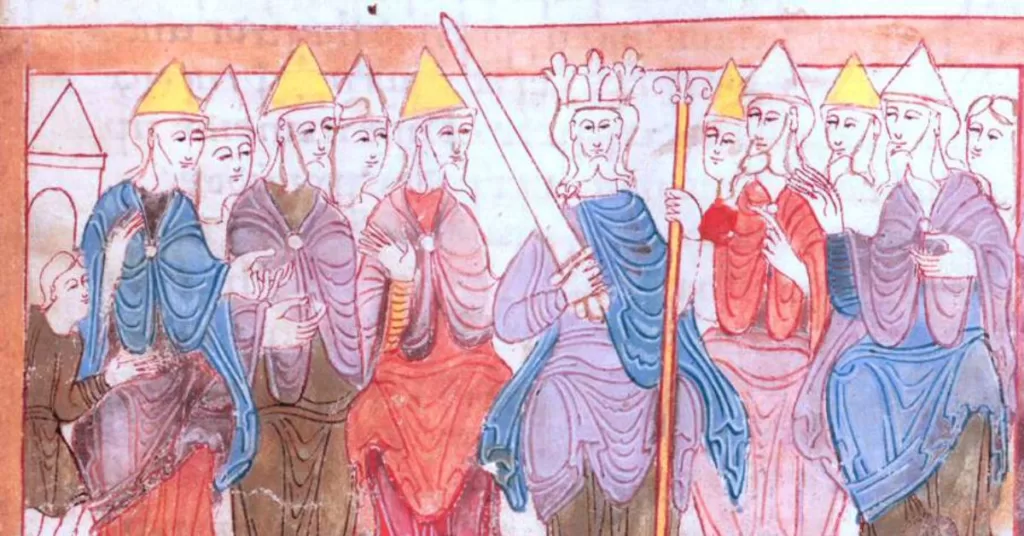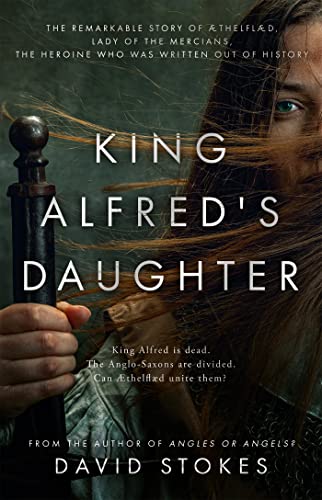Book Review: “King Alfred’s Daughter” by David Stokes
Anglo-Saxon England conjures up images of fair-haired warriors battling Vikings in horned helmets as they pillage local monasteries. Dust spews up from beneath scuffed boots and thundering hooves. Weapons glint in the sun, and screams and battle cries rent the air. Gives me real Lord of the Rings vibes! Except you’ll read about this in King Alfred’s Daughter …sans horned helms.
In King Alfred’s Daughter, British author David Stokes suffuses meticulous research with vibrant storytelling to tell the story of Æthelflæd, Lady of the Mercians (c. 870 – June 12, 918). The daughter of King Alfred the Great and his wife Ealhswith, Æthelflæd lives during a tumultuous time in history, fraught with volatile geopolitics, the slow but progressive creation of a unified England, and Viking raids. Our tenacious, intelligent, devout, and occasionally naïve heroine must step into the boots of her legendary father and fulfill his dream: uniting the Anglo-Saxon peoples under one leader.

Historical Context
The Political Landscape
Æthelflæd lived during the ninth and tenth centuries, a formative time in English history. England as a unified country didn’t yet exist, but the once-disparate kingdoms slowly began to meld together. Anglo-Saxon England resembled something of a geographical patchwork quilt. The kingdoms of Wessex, Mercia, and Northumberland occupied the southern, central, and northern portions of England. Scotland harbored Picts to the far north, the Cornish thrived in the southwestern peninsula, and the Welsh were tucked to the west. The eastern part of Mercia fell under the control of the Danish, and this land became known as the Danelaw.

Martin J. Ryan, in Anglo-Saxon England, perhaps best summarizes the nature of Wessexian politics and unification under one ruler in the tenth-century:
“That a unified England would emerge over the course of the tenth century does not mean that such unity was inevitable nor that there had long existed the idea of or the desire for political unification, an England impatiently waiting to be born.” Ryan further expresses that West Saxon territorial expansion ebbed and flowed throughout the course of the tenth century, characterized by “shifting allegiances, temporary alliances and fluctuating levels of power and authority.”1Martin J. Ryan, “Conquest, Reform, and the Making of England,” in The Anglo-Saxon World (New Haven, CT: Yale University Press, 2013): 284-287.
Alfred the Great and His Reforms
So where does Alfred fit into all of this? And, how was he able to expand and maintain West Saxon holdings?
In an effort to consolidate his hold on his kingdom, Alfred exerted his control through both military reorganization and the building of burhs, or fortified settlements including both soldiers and civilians within an enclosed location.
The fyrd comprised, as Tim Clarkson writes, “the armed retinues of noblemen who were obliged to bring their forces to supplement the royal warband”2Tim Clarkson, Æthelflæd: Lady of the Mercians (Edinburgh: John Donald, 2018): 76. This had long been the traditional method of war-mustering rather than a ruler having a standing army, as was common in later periods. Alfred shifted his fyrd into a more permanent force, able to more quickly fortify his burhs and embark on military campaigns. As a result, the campaigning season could feasibly follow a more ad hoc schedule rather than fall subject to seasonal considerations such as planting in spring and harvesting in the autumn.
In addition to the fyrd reorganization, Alfred’s construction of burhs allowed him to guard his lands. Under later kings such as Edward the Elder, the burhs also served as locations from which to launch campaigns aimed at territorial expansion. A tenth-century document known as the Burghal Hidage lists 33 burhs including Winchester, Exeter, Southampton, Bath, Malmesbury, Worcester, and Warwick. Some of these still survive to the present day. During her reign, Æthelflæd continued the burh program, and this features strongly in the novel.
The Lord and Lady of the Mercians
Æthelflæd became known as “Lady of the Mercians” by virtue of her marriage to Æthelred, a Mercian nobleman whose familial origins are unknown. Alfred wed her to his comrade to shore up the alliance between Wessex and Mercia. Later, Æthelflæd and Æthelred had one daughter named Ælfwynn.
The true nature of the alliance between Wessex and Mercia, especially during Æthelflæd’s reign, remains up for debate. Was Mercia a kingdom and its rulers regarded as monarchs? Or was Mercia more subordinate to Alfred and later Edward the Elder? Some contend that Æthelred ruled as king in name and action, given that his status appears as rex (Latin for “king”) in both a version of the Anglo-Saxon Chronicle and Irish sources.3Ibid., 87. It presents an interesting dichotomy and discussion, one Stokes explores in King Alfred’s Daughter.
Regardless of the specific nuances of their rule, Mercia continued the Alfredian burh scheme, as noted above, and worked to restore its border to its full pre-Danelaw extent. Mercia alternated between periods of conflict and peace with the Danish Vikings as well as incursions from the Norse-Irish.4For more information, check out F.T. Wainwright’s 1948 article on Ingimund’s invasion (subscription may be required).
Æthelflæd played a key role in ensuring the stability of her lands. Her efforts would later help unify the Anglo-Saxon kingdoms under one ruler.

Synopsis
King Alfred’s Daughter begins in the period after Alfred’s death in 899 CE. Æthelflæd returns for his funeral in Winchester, and the author immediately thrusts the reader into the complex politicking of Anglo-Saxon England. Her brother Edward has assumed the Wessexian throne, alienating his sister with his ambitious and arrogant nature. Despite this, both siblings must contend with threats to domestic and foreign incursions to their landholdings.
Domestically, rebels challenge Edward’s accession to the throne in 902 CE. His cousin Æthelwold claims the throne as the son of Alfred’s elder brother and predecessor. Bolstered by a few Mercian nobles and Danish allies, Æthelwold engages his kin in battle at the Battle of the Holme, ultimately losing his life. Æthelflæd and the king’s efforts extinguish this particular threat, but Edward casts aspersions on his sister, questioning her loyalty. This increases the rift between them, even as Æthelflæd takes on Edward’s young son Æthelstan as her ward.
Foreign threats also challenge the Anglo-Saxons. Firstly, a group of Norse-Irish, led by a man named Ingimund, entreats Æthelflæd for permission to settle on her land. Mercians and the Norse-Irish live side-by-side harmoniously, but only for a short time before the newcomers challenge Mercian stability. It falls to Æthelflæd to counter this peril as her husband Æthelred lies bedridden with illness. Upon his death, the Witan, the king’s council, elect her to step in to rule as Lady of the Mercians. Her goal now is to protect her people against Viking attacks.
Can Æthelflæd unite her people during a tumultuous time of ever-shifting alliances and fluctuating geopolitics? How will history remember this princess? And, perhaps most importantly, what is the legacy King Alfred’s daughter leaves behind?
Review
King Alfred’s Daughter presents readers with a historically authentic portrayal of Anglo-Saxon England through the eyes of a devout, intelligent, and loyal heroine. Though few sources survive, historians know Æthelflæd through a few documents including the Mercian Register (also called the Annals of Æthelflæd), a pro-Mercian chronicle detailing events during the reign of King Edward. Author David Stokes takes the frayed ends of these sources and rumors and weaves them together into a plausible tapestry.
Generally, Anglo-Saxon noblewomen yielded little power outside abbeys. Clarkson notes that queens occasionally appeared as witnesses to charters, but beyond that, history relegates these remarkable women as footnotes in a firmly patriarchal society.5Ibid., 93-98. Æthelflæd proves an exception to this rule, and Stokes admirably fleshes her out while remaining true to the historical record and historiography.
The novel’s Æthelflæd must balance her loyalty to her father’s memory and legacy, the blade’s edge of Mercian sovereignty and Wessexian oversight, and various incursions to ensure the survival of herself, her family, and her people. Of course, it’s impossible to assuredly know Æthelflæd’s feelings in the circumstances in which she found herself. Despite this, I found Stoke’s characterization of the princess believable and realistic. Indeed, the story reads almost as a memoir or journal, a type of narrative structure which works well.
Final Thoughts
King Alfred’s Daughter is a solid piece of historical fiction. Readers will find themselves drawn to the history of the period, written in a very approachable manner which lends well to further exploration. They’ll also appreciate the cast of nuanced characters, from the wise-beyond-his-years Æthelstan and gruff and ursine Æthelred to the heroine herself. History ascribes many great deeds to Lady Æthelflæd, and I highly recommend learning about them for yourself.
Thank you to Mr. Stokes for a copy of his wonderful novel!
Further Reading
- Tim Clarkson, Æthelflæd: Lady of the Mercians
- M.J. Ryan and Nicholas Higham, The Anglo-Saxon World
Book Summary

Title: King Alfred’s Daughter
Author: David A. Stokes
Publisher: Book Guild Publishing, Ltd
Publication Year: 2023
Page Count: 300pp
Featured image: Anglo-Saxon king with his witan, in the Old English Hexateuch, c. 11th and 12th centuries (British Library, Cotton MS Claudius B IV)


One Comment